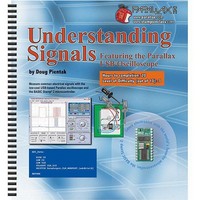70009 Parallax Inc, 70009 Datasheet - Page 31

70009
Manufacturer Part Number
70009
Description
BOOK UNDERSTANDING SIGNALS
Manufacturer
Parallax Inc
Type
Signal Analysisr
Datasheet
1.70009.pdf
(137 pages)
Specifications of 70009
Style
Book
Title
Understanding Signals
Contents
Guide to Generate, View and Measure Wave Forms
Product
Microcontroller Accessories
Lead Free Status / RoHS Status
Not applicable / Not applicable
Other names
70009PAR
Available stocks
Company
Part Number
Manufacturer
Quantity
Price
Company:
Part Number:
700090B
Manufacturer:
COPAL
Quantity:
5 510
Company:
Part Number:
70009CB
Manufacturer:
VISHAY
Quantity:
5 510
Part Number:
70009GB
Manufacturer:
TI/PHILIPS
Quantity:
20 000
Chapter #2: Servo Pulse Square Waves
PULSE WIDTH MODULATION AND HOBBY SERVOS
The focus of this chapter will be to measure and understand the pulses used to control
servos. A servo is a type of tiny motor commonly used in radio-controlled hobby
vehicles, and is also popular in robotics. Among the most difficult tasks for a hobbyist or
amateur robotics enthusiast is to understand the timing of servo control as it relates to
servo positioning.
The Parallax Boe-Bot and Toddler robots use servos for locomotion. Servos typically
have a range of motion of 180°. When modified for continuous rotation, the standard
hobbyist servo becomes a bi-directional, speed-controlled motor.
Servos have three leads: 6 V (red); signal (white), and ground (black). Servos are
controlled by a sequence of pulses. Each pulse is 1-2 ms wide, and there must be ~20 ms
of time between each pulse, as shown in Figure 2-1. The width of this 1-2 ms pulse sets
the servo position (or speed/direction for modified servos) with 1.5 ms being the mid
position (or stopped for modified servos). From a BASIC Stamp’s perspective, this is
quite convenient in that it can use the 20 ms of time between pulses to read sensors,
perform calculations, and execute other code.
Hobby servo control is featured throughout Parallax Stamps in Class documentation. For
more details on servo control, check out the following Stamps in Class texts:
What’s a Microcontroller? Contains simple examples for controlling standard servos.
Robotics with the Boe-Bot The Boe-Bot uses continuous rotation servos to drive its wheels.
servos to achieve its bipedal stride.
See the Further Investigation section at the end of this chapter for details.
Advanced Robotics with the Toddler: The Toddler depends on precision control of standard
Figure 2-1:
Servo control
signal example
A 1 ms pulse
positions the
servo in one
location.



















